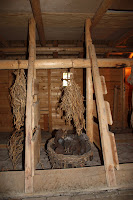Y3W16 - Giethoorn, Netherlands
One of the real perks of living abroad in Germany versus vacationing in Europe is the opportunity to dedicate some time to visiting the smaller, out-of-the-way places that travelers have a hard time prioritizing over Paris, Rome, Berlin, Amsterdam, London, and all the other major cities. Some of our best memories are from day trips planned to explore these local places. A couple months ago, I was asking each of the girls which place they most enjoyed visiting and Avery answered that Münster was her favorite. Münster? Last summer, we took a day trip to Münster – visiting the zoo in the morning and then taking the scenic route home through Münsterland with its many Wasserschlosses. In all we saw three moated castles that day. One even had an extensive playground on the grounds equipped with trampolines.
We’ve asked around and done our own research and as a result come up with some real gems. This weekend was one of our best. Browsing through my travel book a couple weeks ago, I stumbled upon the description of little village in the Netherlands named Giethoorn. Historically, it was a farming town which sat on marshes filled with dense peat. The picture below shows it’s appearance – dense, black, and hard almost as if it was a black brick. This peat was harvested from the ground and used primarily for fuel in the stoves but also for home construction.
In addition to Giethoorn, we also had discovered a national park, De Hoge Veluwe, in nearby Gelderland which is an odd dry, arid section of the Netherlands surrounded by lush green landscape. Driving through the park, one would think that they were in the western United States or Mexico.
The Visitors Center at the De Hoge Veluwe has a museum, Museonder, which describes life underground. The visit invoked memories and thoughts of El’s dad. As we looked at displays and exhibits describing the flow of ground water, we envisioned Grandpa Frank (a geologist/ground water specialist) being all excited to describe the details to anyone that would listen. He and Bailey would have definitely slowed us down. While I never met Ellyn’s dad, I’ve heard enough stories to know that he would have been enjoying himself at this place.
We’ve asked around and done our own research and as a result come up with some real gems. This weekend was one of our best. Browsing through my travel book a couple weeks ago, I stumbled upon the description of little village in the Netherlands named Giethoorn. Historically, it was a farming town which sat on marshes filled with dense peat. The picture below shows it’s appearance – dense, black, and hard almost as if it was a black brick. This peat was harvested from the ground and used primarily for fuel in the stoves but also for home construction.
The excavation and transportation process resulted in miles (~4.5 miles) of canals throughout the community. The homes are a treasure chest of classic thatched roofed dwellings – all of them connected to the walk ways with arched wooden bridges (how cool would it be to have your own bridge as an entrance way).
People travel the canals either by ‘punts’ (think Venice) or by small boats with quiet electric motors that keep the peace. Visitors such as us can rent these vessels for a couple hours.
We took advantage and enjoyed two hours cruising the canals and nearby lake. Even the girls got to drive the boat!
In addition to Giethoorn, we also had discovered a national park, De Hoge Veluwe, in nearby Gelderland which is an odd dry, arid section of the Netherlands surrounded by lush green landscape. Driving through the park, one would think that they were in the western United States or Mexico.
One the of highlights of the park, strangely enough, is an amazing museum – the Köller-Müller Art Museum. This park and museum were both the donation of Helene Kröller-Müller (1869-1939). Her personal collection grew to include 91 paintings and 175 drawings by Vincent Van Gogh including classics such as the Terrace of a café at night and the Potato Eaters. It was fun to watch the girls point out particular pictures and realize that they had visited the sites in southern France that were portrayed in the paintings, and not only were they recognizing the places but they were actually looking at the art.
At one moment, we looked in careful amazement at Georges Seurat’s La Chahut which utilizes his trademark pointillism technique (tiny dots of paint that combine to form a greater scene and blending of colors). In addition to the art collection, we were able to stroll the gardens filled with sculptures (some on which you could climb...)
The Visitors Center at the De Hoge Veluwe has a museum, Museonder, which describes life underground. The visit invoked memories and thoughts of El’s dad. As we looked at displays and exhibits describing the flow of ground water, we envisioned Grandpa Frank (a geologist/ground water specialist) being all excited to describe the details to anyone that would listen. He and Bailey would have definitely slowed us down. While I never met Ellyn’s dad, I’ve heard enough stories to know that he would have been enjoying himself at this place.


















Comments